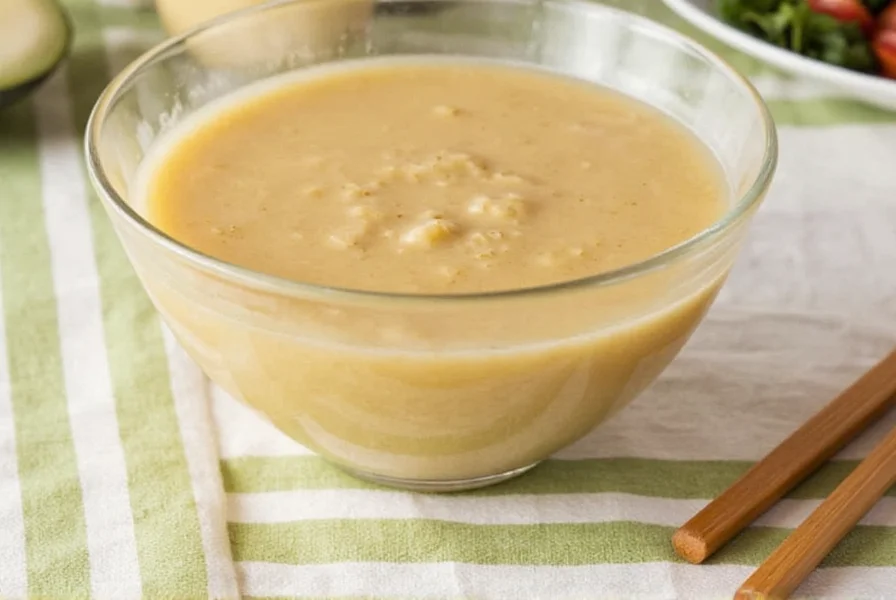Japanese ginger salad dressing represents a perfect balance of sweet, salty, and spicy flavors that has become popular worldwide. Unlike heavier Western dressings, this Japanese staple features fresh ginger as its star ingredient, providing both distinctive flavor and digestive benefits. The authentic preparation method involves freshly grating ginger root to release its volatile oils, which creates a more complex flavor than using powdered alternatives.
Core Ingredients and Their Roles
Understanding each component helps recreate an authentic Japanese ginger dressing. The traditional formula maintains specific ratios that balance flavors harmoniously:
| Ingredient | Traditional Amount | Function |
|---|---|---|
| Fresh ginger root | 1-2 tablespoons grated | Provides spicy warmth and aromatic complexity |
| Rice vinegar | 3 tablespoons | Offers mild acidity without overpowering other flavors |
| Soy sauce | 2 tablespoons | Contributes umami and saltiness |
| Sesame oil | 1 tablespoon | Adds nutty depth and helps emulsify |
| Rice syrup or mirin | 1-2 tablespoons | Provides subtle sweetness to balance acidity |

Traditional Preparation Method
Authentic Japanese ginger dressing requires specific preparation techniques that maximize flavor extraction. Chefs in Japan typically use a suribachi (Japanese mortar) to grind ginger with a small amount of salt, which helps break down fibers and release essential oils. This method produces a more intense ginger flavor than simple grating.
The dressing should be made shortly before serving, as the ginger's volatile compounds dissipate over time. For best results, combine all ingredients in a glass jar and shake vigorously for 30 seconds until emulsified. Let the mixture rest for 15 minutes to allow flavors to meld before using.
Differences Between Japanese and Western Adaptations
Many Western versions of Japanese ginger dressing contain ingredients not traditionally used in Japan:
- Mayonnaise or oil bases - Authentic versions use minimal oil, relying on vinegar and soy for the base
- Powdered ginger - Freshly grated provides superior flavor complexity
- Sugar instead of rice syrup - Creates a different sweetness profile
- Additional spices - Like garlic or chili that aren't traditional
Understanding these differences helps recreate an authentic experience rather than a fusion version.
Perfect Pairings for Japanese Ginger Dressing
This versatile dressing complements specific salad components particularly well:
- Simple green salads with mizuna, watercress, or baby spinach
- Seaweed salads featuring wakame or hijiki
- Cucumber salads with paper-thin slices
- Shredded vegetable salads with daikon, carrot, and bell peppers
- Grilled vegetable salads featuring eggplant or asparagus
Avoid using this delicate dressing with strongly flavored ingredients like blue cheese or beets, which will overpower its subtle balance.
Storage and Shelf Life Considerations
Unlike commercial dressings with preservatives, authentic Japanese ginger dressing has limited shelf life:
- Refrigerate in an airtight container for up to 3 days
- The ginger flavor will gradually intensify over time
- Separation is normal - simply shake before use
- Do not freeze, as this alters the delicate flavor balance
Common Preparation Mistakes to Avoid
Even experienced cooks make these errors when preparing Japanese ginger dressing:
- Using old or dried ginger - Fresh ginger should feel firm with smooth skin
- Over-processing the ginger - Creates bitter compounds
- Adding ingredients in wrong order - Combine acidic components first
- Using low-quality soy sauce - Choose naturally brewed for best flavor
- Not balancing sweet-salty ratio - Taste and adjust before serving
Customizing Your Ginger Dressing
While maintaining the core formula, you can create variations that suit different preferences:
- For extra richness: Add 1 teaspoon toasted sesame seeds
- For citrus notes: Include 1 teaspoon yuzu or lemon zest
- For creamier texture: Blend with 1 tablespoon silken tofu
- For heat variation: Add a pinch of shichimi togarashi
- For vegetarian/vegan: Ensure mirin is non-sweetened variety
Conclusion
Authentic Japanese ginger salad dressing offers a refreshing alternative to heavier Western dressings. By focusing on fresh ingredients and proper technique, you can create a dressing that enhances rather than overwhelms your salads. The key lies in balancing the ginger's natural heat with complementary sweet and salty elements while maintaining the light texture characteristic of Japanese cuisine. Whether you're preparing a simple cucumber salad or a more complex vegetable arrangement, this dressing provides the perfect finishing touch that honors Japanese culinary traditions.
Frequently Asked Questions
Can I substitute ground ginger for fresh in Japanese salad dressing?
While possible in a pinch, ground ginger creates a significantly different flavor profile. Freshly grated ginger contains volatile oils that provide complex aromatic notes unavailable in powdered form. If substituting, use 1/4 teaspoon ground ginger per tablespoon of fresh, but expect a less vibrant, one-dimensional flavor.
Why does my homemade Japanese ginger dressing separate?
Separation occurs because authentic Japanese ginger dressing contains minimal emulsifiers. Unlike Western dressings that use egg yolks or mustard, traditional versions rely on the natural properties of sesame oil. Simply shake vigorously before use. Adding 1/2 teaspoon of mirin can help stabilize the emulsion without altering the authentic flavor profile.
What's the difference between Japanese ginger dressing and Chinese ginger dressing?
Japanese versions typically use rice vinegar and soy sauce with a lighter, more delicate balance, while Chinese ginger dressings often feature black vinegar and additional garlic. Japanese dressings emphasize subtle sweetness from rice syrup, whereas Chinese versions may use more sugar and have a stronger garlic presence. The ginger preparation also differs, with Japanese cuisine preferring freshly grated while Chinese sometimes uses minced.
How can I make Japanese ginger dressing less spicy?
To reduce spiciness without compromising authenticity, try these methods: use younger ginger which is milder, remove the ginger pulp after steeping for 5 minutes, increase the rice syrup slightly, or add a small amount of neutral oil. Never remove ginger entirely as it's essential to the dressing's character - instead, adjust the quantity based on your tolerance.










 浙公网安备
33010002000092号
浙公网安备
33010002000092号 浙B2-20120091-4
浙B2-20120091-4